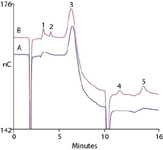Determination of Chelating Agents in Wastewater
Aminopolycarboxylate chelating agents form stable complexes with transition metals, thereby increasing metal solubility, preventing metal-catalyzed reactions, and removing heavy metal contamination in soil remediation.
Terri T. Christison, Brian M. De Borba, and Jeffrey S. Rohrer, Dionex Corporation
Aminopolycarboxylate chelating agents form stable complexes with transition metals, thereby increasing metal solubility, preventing metal-catalyzed reactions, and removing heavy metal contamination in soil remediation (1,2). Chelating agents are typically discharged from wastewater treatment plants in large quantities and interfere with toxic metal removal, thereby releasing metals into the environment (2). The European Aminocarboxylates Committee established a 2.2 mg/L predicted no effect concentration limit as an acceptable level for chelatings agents (1). Therefore, reliable analytical methods are needed to monitor wastewater for regulatory compliance and address increasing public concerns.
This article describes the determination of µg/L concentrations of four chelators in a municipal wastewater sample. Chelating agents are separated on a high-capacity IonPac® AS7 anion-exchange column using methanesulfonic acid (MSA) and detected by pulsed amperometric detection (PAD) with a Pt electrode. The unique column and PAD provide sensitive and selective detection of chelating agents in high ionic strength wastewater samples.
Experimental
A Dionex ICS-3000 Ion Chromatography System and Chromeleon® Chromatography Data System software were used in this study. The conditions are listed in Figure 1.

Figure 1: A) A municipal wastewater effluent. B) Sample A with chelates added. Column: IonPac AS7 set, (2 mm); eluent: 35 mM MSA from -5 to 1 min, 100 mM MSA from 1 to 12 min, 35 mM MSA from 12 to 16 min; temperature: 30 °C; flow rate: 0.3 mL/min; trap column: IonPac CTC-1; injection volume: 25 µL; detection: PAD, Pt (2); sample preparation: degassed, filtered, diluted 1:10. Peaks: 1: EDTA (A, 0.024; B, 0.203 mg/L). 2: NTA (A, -; B, 0.210). 3: System. 4: DTPA (A, -; B, 0.259). 5: EGTA (A, 0.18, B, 0.698).
Results
This high-capacity IonPac AS7 column is specifically designed to separate polyvalent anions using a strong acid eluent. The MSA eluent partially protonates the chelates, thus reducing their effective charge and allowing them to bind and elute within <20 min. NTA and EDTA peaks were resolved from the void using 35 mM MSA while DTPA and EGTA eluted in 16 min using 100 mM MSA. The method was sensitive with an LOQ (10 × S/N) of 50–210 µg/L. Figure 1 shows a chromatogram of a 1:10 diluted municipal wastewater effluent sample with and without added chelates (Figures 1A and 1B). PAD selectively detects the chelating agents without detecting common anions. This ion chromatography-PAD method is accurate (95–101% recoveries) and eliminates postcolumn derivatization, which saves money and time.
References
(1) O. J. Grundler et al., Overview of the European Risk Assessment on EDTA. ACS Symposium Series 910, American Chemical Society: Washington, DC, 336–347 (2005).
(2) W. W. Bedsworth et al., Effects of EDTA on Pollutant Metal Removal by Municipal Wastewater Treatment Plants. ACS Presentation, March 26–30, (2000).
(3) Dionex Corporation Application Note 268, (LPN 2664, 2010), Sunnyvale, CA, (2010).
IonPac and Chromeleon are registered trademarks of Dionex Corporation.
Dionex Corporation
1228 Titan Way, P.O. Box 3603, Sunnyvale, CA 94088
tel. (408) 737-0700, fax (408) 730-9403
Website: www.dionex.com

Separation of Ultra-Short and Long Chain PFAS Compounds Using a Positive Charge Surface Column
December 11th 2024A separation of ultra-short and long chain PFAS (C1-C18) is performed on a HALO®PCS Phenyl-Hexyl column along with a HALO®PFAS Delay column which demonstrates excellent retention for both hydrophilic and hydrophobic analytes.

.png&w=3840&q=75)

.png&w=3840&q=75)



.png&w=3840&q=75)



.png&w=3840&q=75)














